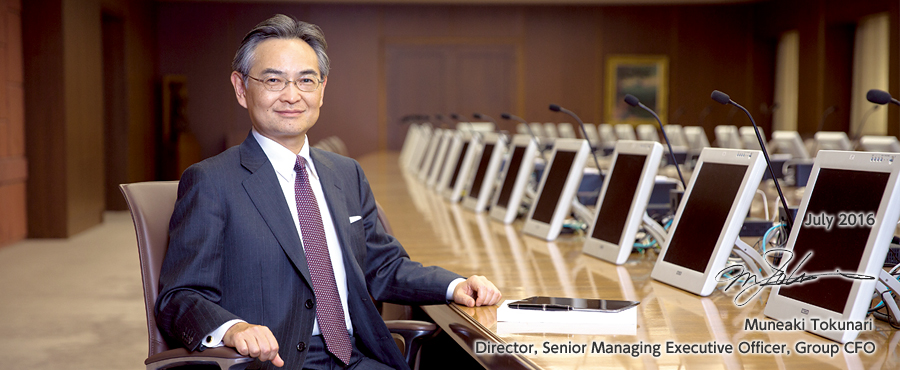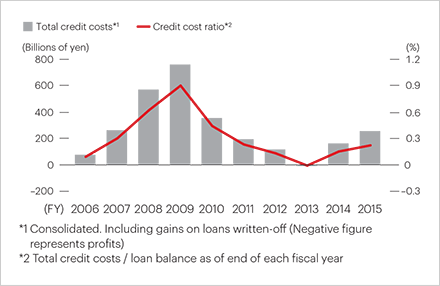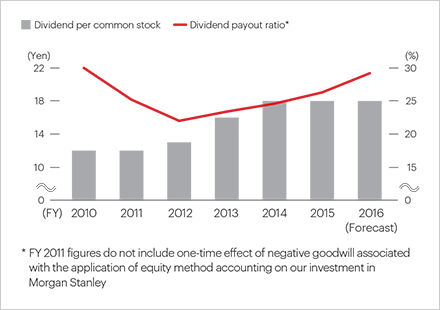Message from the CFO

Fiscal 2015 Business Results
In fiscal year 2015, which ended March 31, 2016, the yen continued to appreciate even as the low interest rate environment was prolonged. In the second half of the fiscal year, factors such as the deceleration of growth in China and other emerging economies and the interest rate hike in the United States led to a volatile market environment. Loans and deposit revenues affected by these circumstances decreased in both Japan and the rest of the world, while fee and commission income increased. Gross profits were down approximately 2% year on year to ¥4,143.2 billion.
Overall expenses stayed virtually unchanged compared with the previous fiscal year, thanks to the success of our cost control efforts, which offset an increase in expenses associated with measures implemented to respond to global financial regulations.
As a result, net business profits decreased approximately 5% year on year to ¥1,557.9 billion.
Credit costs amounted to ¥255.1 billion, reflecting increased costs attributable to a fall in resource and energy prices and the downgrade of ratings for some major clients.
Earnings from equity method investees increased, thanks to the favorable performance of Morgan Stanley, our strategic partner in the United States.
Taking all this data into account, profit attributable to owners of the parent totaled ¥951.4 billion, which represents an approximately 8% year-on-year decrease but slightly exceeds the previously announced target of ¥950.0 billion.
(For more details, refer to the “Financial Review for Fiscal 2015” on >page)
In the current medium-term business plan, MUFG is aiming to achieve financial targets for the four metrics presented below, representing growth, profitability, and financial strength. Although the operating environment surrounding MUFG has been getting harsher since the announcement of the medium-term business plan a year ago, we will continue to strive to achieve these targets by the end of the final year of the plan.

*1 For details on calculation methods, please also see descriptions on ROE featured in “Financial Highlights” on
>page.
*2 Calculated on the basis of regulations applied at the end of March 2019
Forecasts of Fiscal 2016 Operating Environment and Countermeasures
Three Adverse Factors
Having embarked on the year ending March 31, 2017, we have identified three adverse factors, namely, the deceleration of growth in the global economy, credit costs, and a prolonged global environment of low interest rates, all of which place burdens on the operations of financial institutions.
To overcome these factors, MUFG will demonstrate the comprehensive strengths of the MUFG Group as much as possible by providing our customers with truly valuable services and solutions to meet their needs. We are confident that by doing so, we can expand transactions while securing more diverse revenue sources.
In addition, we will progressively implement a number of other initiatives aimed at curbing costs and improving productivity while maintaining stringent credit risk management. Details of the initiatives follow.
Status of Credit Costs
Credit costs currently account for around 0.2% of total loan balances, indicating that overall asset quality is strong.
The credit balance in energy- and resource-related sectors totaled ¥10.4 trillion at the end of fiscal year 2015. After deducting exposures backed by collateral and guarantees pledged by such institutions as the Export Credit Agency, the credit balance amounts to ¥6.9 trillion. More than 90% of this amount consists of exposures to normal borrowers. Non-performing loans are only approximately ¥120 billion, 90% of which has already been secured by collateral. Looking ahead, we will implement more stringent credit risk management.
(For more details, refer to the “Financial Review for Fiscal 2015” on
> page)

Impact of Negative Interest Rates
Due to the negative interest rate policy introduced by the Bank of Japan in February 2016, we are seeing downward pressure on our interest income in Japan.
To address the situation, our Retail Banking Business Group and Asset Management / Investor Services Business Group are collaborating to facilitate a shift of financial products owned by our customers from savings to investment through initiatives such as enhancing our lineup of investment products.
At the same time, we are promoting housing loans and apartment loans in response to growing demand in these markets due to the lower interest rates.
Regarding large deposits, we have set limits on balances in yen banking accounts for inter-bank settlement services held by overseas financial institutions and have begun charging additional fees on over-limit balances.
We are actively exploring the potential loan demand of domestic corporate customers by leveraging favorable aspects of the low-interest-rate policy. We are also monitoring the balances of large deposits and developing more sophisticated methods to manage the comprehensive profitability of customer transactions.
Improving Productivity
To offset a decrease of profits due to the aforementioned three adverse factors, it is essential to improve productivity and further curb costs.
With this in mind, we are implementing Groupwide initiatives, including the reorganization of our network in the Americas and Europe and the integration of our sales & trading business that the commercial bank and securities company are currently undertaking to streamline their overlapping functions. In addition, we will steadily implement measures aimed at the appropriate allocation of human resources, including downsizing the number of career-track employees, to effectively use talent within the Group and improve productivity.
Capital Management

Maintenance of a Solid Capital Base
As a Global Systemically Important Bank, MUFG is subject to the Basel III international rules that require financial institutions to solidify their capital base. As of March 31, 2016, MUFG’s capital adequacy ratio (Common Equity Tier1 Capital ratio), an indicator of the soundness of its capital base, was more than 11%, well exceeding the Basel III minimum requirement of 8.5%. As such, MUFG is maintaining the adequate capital ratio level required by current financial regulations.
Today, however, relevant authorities across national boundaries are engaging in international discussions aimed at introducing new capital regulations. Moreover, regulations on Total Loss Absorbing Capacity (TLAC) requirements are expected to be enacted in March 2019.
(For more details, refer to “Responding to Global Financial Regulation” on >page)
We need to comply with these regulations while enhancing our ROE. From this point of view, it is important to create an optimal capital structure, which we call “the best capital mix,” by appropriately combining Additional Tier1 Capital (e.g., perpetual subordinated debt), Tier2 Capital (e.g., subordinated term debt), and TLAC-eligible senior debt.
In fiscal year 2015, therefore, we implemented a capital raise in multiple layers and channels as stated below. MUFG became the first issuer in Japan engaged in multiple fields, and as a result, MUFG was selected to receive the awards listed below in recognition of its efforts “to play pioneering roles in price formation of the notes issued for the first time in the market and the nurturing of the investor base, as well as its significant contributions to the development of the market.”

Use of Capital to Strengthen Profitability
Strategic investment with excess capital is a key driver for achieving sustainable growth, as well as organic growth based on our existing customer base and businesses. We place our priority on capital productivity in strategic investments such as M&A and require return from the investment to exceed the cost of capital within a certain period of time after the investment. We ensure financial discipline by periodically monitoring the result of investments and establishing internal rules to cope with investments that missed return targets.

Further Enhancement of Shareholder Returns
Our basic strategy on shareholder returns is to achieve stable and sustainable increases in dividends per share through the growth of our profits.
On two occasions in fiscal year 2015, we repurchased our own shares, with the value of each transaction amounting to approximately ¥100 billion each, as part of our efforts to enhance shareholder returns.
We will continue to work toward the enhancement of shareholder returns, while keeping capital ratios at an appropriate level to comply with capital regulations and maintain our ratings while taking into account the possible use of capital for further growth.

Toward Sustainable Growth
Risk Appetite Framework
MUFG has introduced a risk appetite framework to provide a common linguistic platform on which the Chief Strategy Officer, Chief Risk Officer, and CFO, as well as their staff, can discuss business strategies and financial plans.
This framework is designed to clarify risk appetite, which means the types and amount of risk that MUFG is willing to take. The framework helps us better control risk while enabling us to achieve sustainable growth by pursuing as many business opportunities as possible.
(For more details, refer to “Risk Appetite Framework Management Process,” featured in “Risk Management” on >page)
Dialogue with Shareholders and Investors and Information Disclosure
As the CFO of MUFG, I believe it’s important to continue constructive dialogue with stock and bond investors and to further enhance information disclosure. For MUFG as a financial institution, raising capital and debt from capital markets is important in order to comply with financial regulations, maintain our ratings, and ensure foreign currency liquidity. From this point of view, we engaged in dialogue with shareholders and investors in fiscal year 2015 as listed below, in addition to the appropriate disclosure of financial information based on Japanese and U.S. GAAP.
Opinions of shareholders and investors attending dialogue events are periodically reported to the Board of Directors and the Executive Committee and are shared among all management team members.
We will continue to have constructive dialogue with shareholders and investors. Your continuing support will be very much appreciated.

